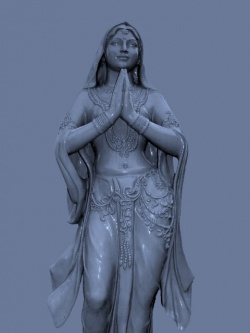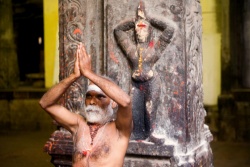Difference between revisions of "Anjali mudra"
(Created page with " Añjali Mudrā (Sanskrit: अञ्जलि मुद्रा) or praṇāmāsana (Sanskrit: प्रणामासन) is a hand gesture w...") |
|||
| (3 intermediate revisions by the same user not shown) | |||
| Line 1: | Line 1: | ||
| − | + | [[File:Añjali Mudrā.jpeg|thumb|250px|]][[File:Indian sadhu performing namaste.jpg|thumb|250px|]] | |
| + | |||
| + | |||
| + | |||
| + | |||
| Line 12: | Line 16: | ||
[[Mudra]] means "{{Wiki|seal}}" or "sign". The meaning of the [[phrase]] is thus "salutation {{Wiki|seal}}". | [[Mudra]] means "{{Wiki|seal}}" or "sign". The meaning of the [[phrase]] is thus "salutation {{Wiki|seal}}". | ||
| − | The gesture is also known as [[hrdayanjali mudra]] meaning "reverence to the | + | The gesture is also known as [[hrdayanjali mudra]] meaning "[[reverence to the heart] seal]]" (from [[hrd]], meaning "[[heart]]") and [[atmanjali mudra]] meaning "[[reverence to the self seal]]" (from [[atman]], meaning "[[self]]"). |
The gesture first appears c. 4000 years ago on the clay [[seals]] of the {{Wiki|Indus Valley}} {{Wiki|Civilization}} | The gesture first appears c. 4000 years ago on the clay [[seals]] of the {{Wiki|Indus Valley}} {{Wiki|Civilization}} | ||
| + | |||
Description | Description | ||
| − | |||
| − | In the most common [[form]] of [[anjali mudra]], the hands are held at the [[heart chakra]] with thumbs resting lightly against the sternum. The gesture may also be performed at the [[Ajna]] or [[brow chakra]] with thumb tips resting against the "[[third eye]]" or at the [[crown chakra]] (above the head). In some [[yoga postures]], the hands are placed in [[anjali mudra]] position to one side of the [[body]] or behind the back. | + | [[Anjali mudra]] is performed by pressing the palms of the hands together. The fingers are together with fingertips pointing up. The hands are pressed together firmly and evenly. |
| + | |||
| + | In the most common [[form]] of [[anjali mudra]], the hands are held at the [[heart chakra]] with thumbs resting lightly against the sternum. | ||
| + | |||
| + | The gesture may also be performed at the [[Ajna]] or [[brow chakra]] with thumb tips resting against the "[[third eye]]" or at the [[crown chakra]] (above the head). | ||
| + | |||
| + | In some [[yoga postures]], the hands are placed in [[anjali mudra]] position to one side of the [[body]] or behind the back. | ||
| + | |||
| + | [[Anjali mudra]] is normally accompanied by a slight [[bowing]] of the head. | ||
| + | |||
| + | |||
| − | |||
[[Symbolic]] meaning | [[Symbolic]] meaning | ||
| − | |||
| − | The gesture is used for both [[greetings]] and farewells, but carries a deeper significance than a simple "hello" or "goodbye". The joining together of the palms is said to provide [[connection]] between the right and left hemispheres of the {{Wiki|brain}} and represents unification or "yoking". This yoking is [[symbolic]] of the practitioner's [[connection]] with the [[divine]] in all things. Hence, performing [[anjali mudra]] is an honouring of both the [[self]] and the other as the gesture acknowledges the [[divinity]] of both [[practitioner]] and recipient. | + | |
| + | [[Anjali mudra]] has the same meaning as the [[Sanskrit]] greeting [[Namaste]] and can be performed while saying [[Namaste]] or [[Pranam]], or in place of vocalizing the [[word]]. | ||
| + | |||
| + | The gesture is used for both [[greetings]] and farewells, but carries a deeper significance than a simple "hello" or "goodbye". | ||
| + | |||
| + | The joining together of the palms is said to provide [[connection]] between the right and left hemispheres of the {{Wiki|brain}} and represents unification or "yoking". | ||
| + | |||
| + | This yoking is [[symbolic]] of the practitioner's [[connection]] with the [[divine]] in all things. | ||
| + | |||
| + | Hence, performing [[anjali mudra]] is an honouring of both the [[self]] and the other as the gesture acknowledges the [[divinity]] of both [[practitioner]] and recipient. | ||
In [[Sri Lanka]] the [[Sinhalese]] gesture of welcome incorporates the words "ayubowan" (may you live long) with both hands placed together on the sternum with a slight [[bow]]. | In [[Sri Lanka]] the [[Sinhalese]] gesture of welcome incorporates the words "ayubowan" (may you live long) with both hands placed together on the sternum with a slight [[bow]]. | ||
| + | |||
| + | |||
[[Physical]] benefits | [[Physical]] benefits | ||
| − | [[Anjali | + | |
| + | |||
| + | [[Anjali mudra]] is performed as part of a [[physical yoga practice]] with an aim to achieving several benefits. | ||
| + | |||
| + | It is a centering pose which helps to alleviate [[mental]] [[stress]] and [[anxiety]] and is therefore used to assist the [[practitioner]] in achieving focus and coming into a [[meditative state]]. | ||
The [[physical]] execution of the pose helps to promote [[flexibility]] in the hands, wrists, fingers and arms. | The [[physical]] execution of the pose helps to promote [[flexibility]] in the hands, wrists, fingers and arms. | ||
Use in full [[body]] [[asanas]] | Use in full [[body]] [[asanas]] | ||
| − | While [[anjali mudra]] may be performed by itself from any seated or [[standing posture]], the gesture is also incorporated into [[physical]] [[yoga practice]] as part of many full-body | + | While [[anjali mudra]] may be performed by itself from any seated or [[standing posture]], the gesture is also incorporated into [[physical]] [[yoga practice]] as part of many [[full-body asanas]] [[including]]: |
| + | |||
| + | |||
<poem> | <poem> | ||
anjaneyasana (lunge) - with arms overhead | anjaneyasana (lunge) - with arms overhead | ||
| Line 49: | Line 78: | ||
vrksasana ([[tree]] pose) | vrksasana ([[tree]] pose) | ||
</poem> | </poem> | ||
| + | {{W}} | ||
| + | [[Category:Anjali mudra]] | ||
| + | [[Category:Buddhist Terms]] | ||
| + | [[Category:Buddhism]] | ||
Latest revision as of 21:19, 30 November 2023
Añjali Mudrā (Sanskrit: अञ्जलि मुद्रा) or praṇāmāsana (Sanskrit: प्रणामासन) is a hand gesture which is practiced throughout Asia and beyond.
It is used as a sign of respect and a greeting in India, Sri Lanka, Nepal, Bhutan, Thailand, Cambodia, Laos, Burma, Indonesia, and amongst yoga practitioners and adherents of similar traditions. The gesture is incorporated into many yoga asanas. The gesture is also used for worship in many Eastern religions.
Anjali is Sanskrit for "divine offering", "a gesture of reverence", "benediction", "salutation", and is derived from anj, meaning "to honour or celebrate".
Mudra means "seal" or "sign". The meaning of the phrase is thus "salutation seal".
The gesture is also known as hrdayanjali mudra meaning "[[reverence to the heart] seal]]" (from hrd, meaning "heart") and atmanjali mudra meaning "reverence to the self seal" (from atman, meaning "self").
The gesture first appears c. 4000 years ago on the clay seals of the Indus Valley Civilization
Description
Anjali mudra is performed by pressing the palms of the hands together. The fingers are together with fingertips pointing up. The hands are pressed together firmly and evenly.
In the most common form of anjali mudra, the hands are held at the heart chakra with thumbs resting lightly against the sternum.
The gesture may also be performed at the Ajna or brow chakra with thumb tips resting against the "third eye" or at the crown chakra (above the head).
In some yoga postures, the hands are placed in anjali mudra position to one side of the body or behind the back.
Anjali mudra is normally accompanied by a slight bowing of the head.
Symbolic meaning
Anjali mudra has the same meaning as the Sanskrit greeting Namaste and can be performed while saying Namaste or Pranam, or in place of vocalizing the word.
The gesture is used for both greetings and farewells, but carries a deeper significance than a simple "hello" or "goodbye".
The joining together of the palms is said to provide connection between the right and left hemispheres of the brain and represents unification or "yoking".
This yoking is symbolic of the practitioner's connection with the divine in all things.
Hence, performing anjali mudra is an honouring of both the self and the other as the gesture acknowledges the divinity of both practitioner and recipient.
In Sri Lanka the Sinhalese gesture of welcome incorporates the words "ayubowan" (may you live long) with both hands placed together on the sternum with a slight bow.
Physical benefits
Anjali mudra is performed as part of a physical yoga practice with an aim to achieving several benefits.
It is a centering pose which helps to alleviate mental stress and anxiety and is therefore used to assist the practitioner in achieving focus and coming into a meditative state.
The physical execution of the pose helps to promote flexibility in the hands, wrists, fingers and arms. Use in full body asanas
While anjali mudra may be performed by itself from any seated or standing posture, the gesture is also incorporated into physical yoga practice as part of many full-body asanas including:
anjaneyasana (lunge) - with arms overhead
hanumanasana (monkey pose)
malasana (garland pose)
matsyasana (fish pose) - an advanced variant
prasarita padottanasana (wide-legged forward bend) - an advanced variant with hands behind the back
tadasana/samasthiti (mountain pose) - a variant of the pose used during sun salutation sequences
Urdhva Hastasana (upward salute/extended mountain pose) - arms overhead
virabhadrasana I (warrior I) - arms overhead
vrksasana (tree pose)

